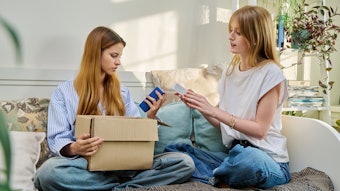While consumers have no control over what happens with national economics, they can control their personal appearance and it seems that today, this is exactly what they are doing. Indeed, according to recent research from Mintel in to color cosmetics, makeup displays just how recession-proof the sector is, with U.K. retail sales of color cosmetics putting on a good performance in 2011, with market value up by over 8% from 2010 (when the market was valued at £1.28 billion) shoring up sales of a stunning £1.38 billion.
Growth is expected to continue—albeit at a slower pace—into 2012 and beyond, to achieve an estimated market worth £1.44 billion in 2012.
Vivenne Rudd, head of beauty and personal care insight at Mintel, commented, "The market turned in a dynamic performance in comparison to other beauty categories like hair care and body care. Furthermore, continued active new product development, an expanding consumer base and fashion trends were additional supporting factors behind the value growth. Prestige brands outperformed mass market brands, with many women favoring premium-positioned products at the expense of the mid-priced segment".
“Confidence is becoming something of a luxury in the current economic climate yet, eight out of ten British women feel more confident when wearing makeup,” Rudd continued. “More than just a lipstick or a cover-up [product], makeup has become the recession’s war paint. In effect women are using makeup to put on a brave face. Sales in the market have continued to grow and will continue to do so for as long as the market delivers the feel-good factor even if the economy cannot.”
While all core sectors (face, eyes, lips and nails) managed growth, nail makeup stole the limelight, posting double-digit growth (£221m in 2011 from £179m in 2010). However, face color cosmetics remains the largest of the four, accounting for 38% of total market value at £526 million. The remainder of the sales are made up of “eyes” valued at £410 million (accounting for 30% of total sales), “lips” valued at £224 million (accounting for 16% of sector sales) and “nails” worth £221 million, accounting for 15% of the market.
Although accounting for the smallest number of sales, nail makeup was the real star performer of the U.K. color cosmetics market in 2011, posting double-digit growth to reach a value of £221 million. Indeed, research shows users of nail varnish have risen from 52% of women in 2007 to an impressive 61% in 2011.
And it is not just Britain that has seen a rise in interest in nail color cosmetics. Indeed, this has been the case across Europe as a whole. In 2008, nail color cosmetics accounted for 10% of all color cosmetic launches; by 2012, this had risen to 26% of all new launches in the sector. In terms of launch activity by region, the UK was the most active region, accounting for 29% of all new product activity in the color cosmetics market during 2012. This was followed by Germany accounting for 22% of all activity and France, which accounted for 20% of activity.
“In terms of color, nails have stolen the limelight from eyes and lips, and have become an arena for self-expression in the form of nail art. While the prim, ladylike look of French manicured nails is unlikely to ever go out of style, recent trends have covered less subtle, even outrageous looks ranging from two-tone manicures and classic red polish to ombre and metallic shades. Nail makeup has also witnessed one of the biggest increases of all core beauty sectors in its consumer base in recent years,” noted Rudd.
Finally, exclusive research finds women do not see makeup as just something utilitarian, but relate to it at an emotional level—eight out of ten (80%) say that wearing makeup makes them feel more confident in themselves and is the main reason for them to wear color cosmetics.
While the main motivation to buy makeup is to replace a worn-out or finished product, nearly two out of five (37%) do it out of the sheer enjoyment of shopping for makeup. With the recession taking a toll on consumer spending power, three in ten (30%) have cut back their spending on makeup and 45% consider inexpensive alternatives to offer as good quality as expensive brands.










